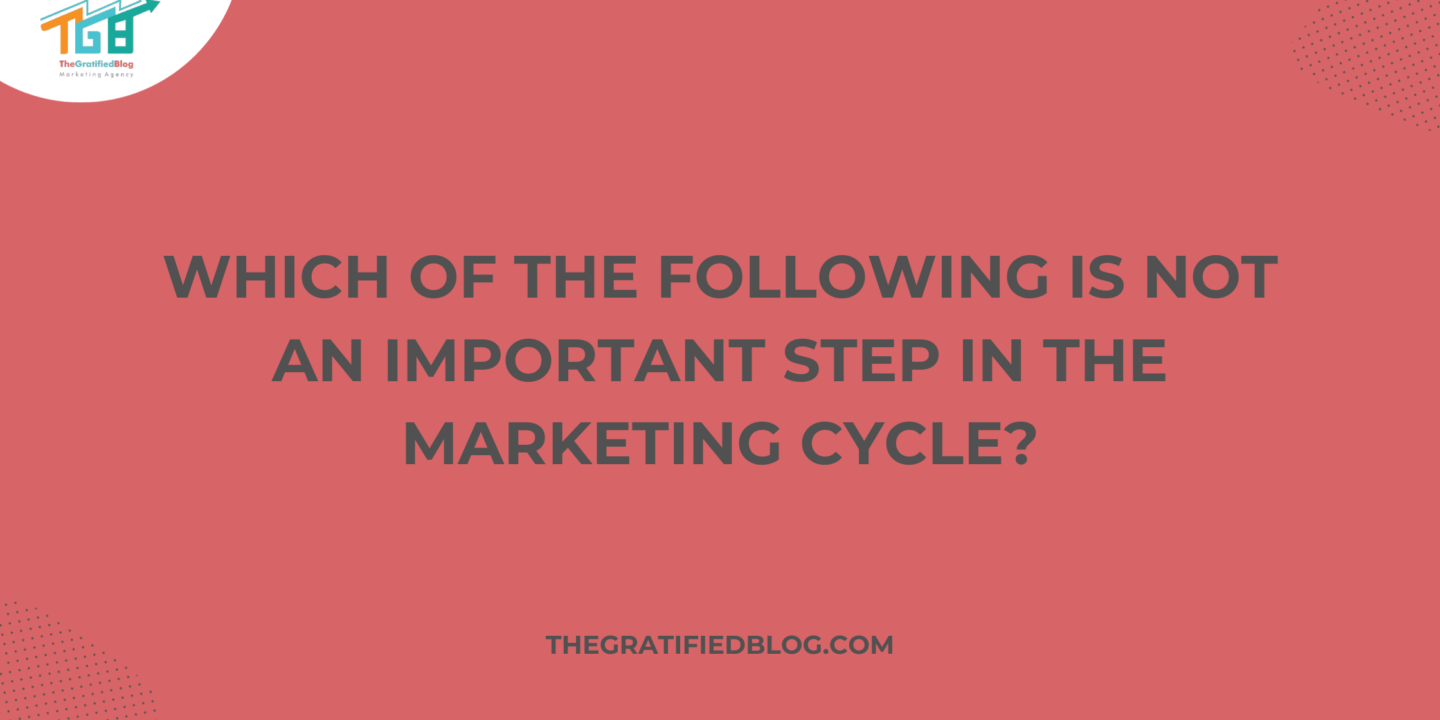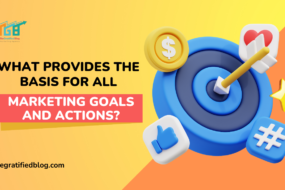
In the busy business world, the marketing cycle is like a friendly guide that helps companies create products and connect with customers. As entrepreneurs and marketers work together, a common question arises: “Which of the following is not an important step in the marketing cycle?” This seemingly simple query conceals layers of complexity, challenging us to unravel the significance of each stage within the marketing journey.
In this exploration, we’re going to dig into the marketing cycle. We’ll look closely at its necessary steps and determine the details that make a business successful in a competitive market. Come along as we make the marketing cycle easier to understand, trying to discover the essential parts that help companies to move forward, including one that might not seem very important at first but plays a significant role in marketing strategies.
So, let’s get started:
Which Of The Following Is Not An Important Step In The Marketing Cycle?
- Market Research
- Product Development
- Pricing
- Promotion
- Sales
- Post-sale Customer Support
Before unraveling the question’s mystery, let’s break down the marketing cycle.
Exploring The Marketing Cycle
Market Research
Comprehensive market research lies at the core of every prosperous marketing strategy. This initial step involves meticulously exploring the target audience’s needs, preferences, and behaviors. Understanding the market landscape, identifying potential opportunities, and uncovering challenges is imperative.
Businesses can gather valuable insights that inform subsequent decisions through surveys, interviews, and data analysis. This research not only aids in defining the target demographic but also provides a nuanced understanding of consumer pain points, desires, and the competitive landscape.
Market research sets the stage for a tailored approach, ensuring that products or services align closely with what the audience truly seeks, thus increasing the likelihood of success in a crowded market.
Product Development
Armed with the insights from market research, the journey progresses to product development. This phase is characterized by innovation, quality assurance, and relevance. The aim is to create a product or service that not only meets the identified needs of the target audience but also distinguishes itself in terms of uniqueness or superior features.
Innovation ensures a competitive edge while focusing on quality, crucial for building and maintaining a positive brand image. Relevance, conversely, ensures that the product aligns with current market trends and consumer expectations.
The product development stage requires a delicate balance between creativity and practicality, and successful execution results in a solution that effectively addresses the identified market gaps.
Pricing
Determining the right price for a product or service involves a delicate balance between covering costs, ensuring profitability, and delivering value to customers. Price elasticity, competition, and perceived value are pivotal factors in this decision-making process. Understanding customers’ sensitivity to price changes helps set a competitive yet sustainable pricing strategy.
Analyzing competitors’ pricing strategies provides insights into market norms and helps position the product effectively. Moreover, the perceived value of the product, shaped by branding and marketing efforts, influences The maximum threshold of what customers are willing to spend.
Pricing is not merely a monetary decision but a strategic one that can significantly impact consumer perception and market positioning.
Promotion
With the product and its pricing strategy in place, the focus shifts to promotion. This stage involves crafting compelling messages and choosing suitable channels to create awareness and interest in the market.
Marketing and advertising endeavors are pivotal in shaping the perception of the product. The goal is to effectively communicate the unique selling propositions, differentiate the product from competitors, and create a positive brand image. The promotional phase utilizes traditional and digital avenues to connect with the target audience, encompassing social media, print, television, and online advertising.
Creativity in messaging and strategic placement are critical components of successful promotion, aiming to inform and establish an emotional bond between the brand and the consumer.
Sales
The culmination of practical marketing efforts is witnessed in the sales phase. That is the point where the actual transaction occurs. Successful sales strategies are crucial, encompassing distribution channels, sales teams, and customer engagement.
The product must be readily available through the chosen channels, and sales teams should be equipped to address customer queries and facilitate the purchase process. The sales phase is not only about closing deals but also about building relationships.
Customer interactions during this stage contribute to brand perception and can influence future buying decisions. A seamless and positive sales experience enhances customer satisfaction and sets the stage for potential repeat business and word-of-mouth referrals.
Post-sale Customer Support
The journey does not conclude with a successful sale but extends into the post-sale phase. Providing excellent customer support is imperative for customer satisfaction, building loyalty, and generating positive word-of-mouth.
This step involves addressing customer queries, resolving issues, and ensuring the customer feels supported even after purchasing. A robust post-sale customer support system contributes to the overall success of the product or service by fostering a positive brand reputation.
Satisfied customers are likelier to become brand advocates, promoting the product to their network and contributing to organic growth. Moreover, an efficient customer support system helps collect feedback, which can be valuable for continuous improvement and refinement of products and services.
Connecting The Dots
Now that we’ve looked closely at the marketing cycle, let’s go back to the question: Which of the following is not an essential step in the marketing cycle?
The answer is Pricing.
While pricing is crucial in marketing, it’s not a standalone step. Instead, it’s interwoven throughout the entire marketing cycle. Market research, product development costs, promotional efforts, and the overall sales strategy influence the pricing decision. It’s a dynamic element that requires constant evaluation and adjustment.
Why Pricing Is Not A Standalone Step
Interconnected With Market Research
Pricing is not an isolated decision; it is intricately linked with market research, forming a symbiotic relationship. Market research yields valuable insights into customer behavior, preferences, and willingness to pay for a product.
By understanding the market dynamics, businesses can gauge the price sensitivity of their target audience. This knowledge is fundamental in shaping the pricing strategy, ensuring that the set price aligns with what customers perceive as reasonable and valuable.
Additionally, market research helps assess the competitive landscape, allowing businesses to position their product effectively regarding features and pricing. In essence, pricing decisions directly reflect the understanding gained through market research, making it an indispensable aspect of the pricing process.
Influenced By Product Development
The costs incurred during the various phases of product development play a crucial role in influencing the final price of a product. Product development encompasses research, production, and distribution, each incurring its own set of costs.
These costs must be factored into the pricing decision to ensure profitability and sustainability. Additionally, the product’s quality, innovation, and uniqueness influence its perceived value in the market. A product with higher development costs may be positioned as a premium offering, justifying a higher price point.
On the contrary, a product designed for mass adoption may follow a cost-effective strategy. Therefore, the link between product development and pricing is inherent, with the former directly shaping the economic considerations that guide the latter.
Shaped By Promotional Efforts
How a product is promoted has a profound impact on its perceived value, influencing the pricing strategy. Promotional efforts create a narrative around the product, shaping customer perceptions and expectations. Suppose a product is positioned as a high-end, premium offering through marketing efforts.
In that case, consumers are more likely to associate it with a higher value and may be willing to pay a premium price. On the other hand, if promotional efforts focus on affordability and value for money, the pricing strategy would need to align with this positioning.
Therefore, pricing is not merely a result of production costs but is dynamically shaped by the promotional narrative crafted by the marketing team. The interplay between promotion and pricing is strategic, aiming to create a perception that resonates with the target audience and supports the overall brand positioning.
Aligned With Sales Strategy
The pricing strategy should be intricately aligned with the broader sales strategy of the business. Different sales approaches necessitate different pricing strategies. For example, a penetration pricing strategy might gain rapid market share by offering lower initial prices. In comparison, a skimming strategy might involve setting higher prices to capitalize on early adopters.
The alignment ensures a cohesive and synchronized approach to market entry and expansion. Furthermore, the pricing strategy influences how the product is perceived in the market, impacting the effectiveness of the sales strategy.
A well-aligned pricing strategy contributes to the overall success of the sales efforts, creating harmony between the product’s value proposition and its perceived worth in the eyes of the consumer.
Continuous Evaluation In The Post-Sale Phase
The post-sale phase is not the end for pricing considerations; instead, it marks the beginning of a continuous evaluation process. Customer feedback and evolving market dynamics may necessitate adjustments to the initial pricing strategy.
Businesses need to be responsive to changing consumer perceptions and market conditions. Continuous evaluation allows for fine-tuning the pricing strategy. The stages of product development are pivotal in shaping business objectives.
Post-sale customer interactions, reviews, and market trends provide valuable data for assessing whether the product delivers the expected value and if adjustments to the pricing strategy are required for sustained success. This ongoing evaluation ensures that the product remains relevant and profitable throughout its lifecycle in the market.
Conclusion
Now that you’ve identified which of the following is not an essential step in the marketing cycle?, why invest in that step? Focus on the steps contributing to better decision-making and drive positive outcomes.
If you still have any questions related to the blog, then feel free to leave them in the comments section. We will be happy to answer you.
Thanks for reading









 By TheGratifiedBlog
By TheGratifiedBlog
No Comments